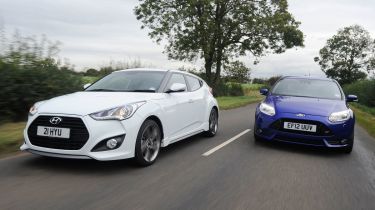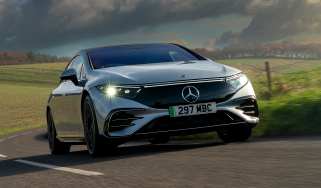Hyundai Veloster Turbo vs Ford Focus ST
Power hike means Hyundai goes up against a serious hot hatch like the Focus ST
Love or hate the Veloster’s bold styling, there’s no doubt it attracts attention. As a result, the car is a big rival for established coupe contenders such as the VW Scirocco.
Yet by adding a powerful engine and an uprated chassis to the surprisingly practical four-door body, Hyundai has placed its coupe in the firing line of some of the best hot hatches in the business – including our reigning champion, the Ford Focus ST.
Parked side-by-side, the Hyundai and the Ford couldn’t look more different. Despite its aggressive grille, chunky sills, huge spoiler and 18-inch alloys, the ST’s humble five-door hatchback roots are clear to see. By contrast, the Veloster’s low-slung lines and coupé styling mean it looks more compact and attracts more attention. But neither car is very attractive, as they each suffer from fussy detailing and tacky looking bodykits.
It’s a similar story inside, where both have angular dashboards with haphazard switches. But the Ford has the edge, thanks to soft-feel plastics and robust construction. Some of the Veloster’s materials look and feel low-rent.
Yet what the Hyundai lacks in quality, it makes up for with kit. In Turbo SE form, it’s packed with gadgets such as sat-nav, climate control, heated seats and keyless entry. The Focus has the essentials covered, with air-con and Bluetooth both featuring, but feels a little spartan after a trip in the Veloster. If you want a similarly equipped Ford, you have to dig deep for the £25,495 ST-3 version – and even then sat-nav and cruise control cost £950.
Used - available now

2018 Audi
A1 Sportback
79,404 milesManualPetrol1.0L
Cash £6,995
2018 Audi
TT
22,262 milesManualPetrol1.8L
Cash £16,495
2018 Fiat
500
29,942 milesManualPetrol1.2L
Cash £7,795
2018 MERCEDES-BENZ
SPRINTER
34,339 milesManualDiesel2.1L
Cash £17,995As you’d expect, the Ford holds all the aces for practicality. With its versatile five-door layout and roomy five-seat cabin, the ST is every bit as family friendly as other models in the Focus line-up, while its 363-litre boot is 43 litres larger than the Hyundai’s. However, in this test, performance is more important than versatility – and the Ford doesn’t disappoint.
Thanks to its muscular 247bhp, 2.0-litre turbo engine, the ST put on a crushing display at the track, rocketing from 0-60mph in only 6.3 seconds – a full 1.7 seconds faster than the Veloster. But it really stamped its authority in our in-gear tests, needing only 6.4 seconds to complete the 50-70mph sprint in sixth. While the Hyundai feels quick and eager on its own, its smooth 1.6-litre engine has no answer to the explosive firepower of the Focus.
On the road, the Ford feels even faster, as it responds eagerly to the throttle, allowing you to breeze past slower traffic. A growling exhaust note and precise six-speed manual gearbox only add to the car’s appeal.
If the Hyundai was on the ropes following this onslaught, then it receives a knock-out blow when the road becomes tight and twisty. The turbocharged Veloster is sharper and more agile than cheaper versions, but it can’t compete with the fast Ford for driving fun. With quick steering, incredible grip and strong body control, the ST is one of the best handling front-wheel-drive cars you can buy.
Its controls are brimming with feedback and the car’s line through a corner can be subtly altered using a mix of throttle and steering. Yes, the ride is a little firmer than the Hyundai’s and there’s some torque steer on bumpy roads, but it’s a small price to pay for such sparkling driving dynamics.
In comparison, the Veloster feels slower to respond to your steering inputs, suffers from more body roll and really struggles for traction coming out of slower corners.
Yet it’s not all good news for the Ford: it costs the same to buy as the Veloster, but has slightly weaker residuals, higher emissions and only a three-year warranty as standard.
So will these flaws stop it from taking victory over the quirky Veloster coupe in this test?



